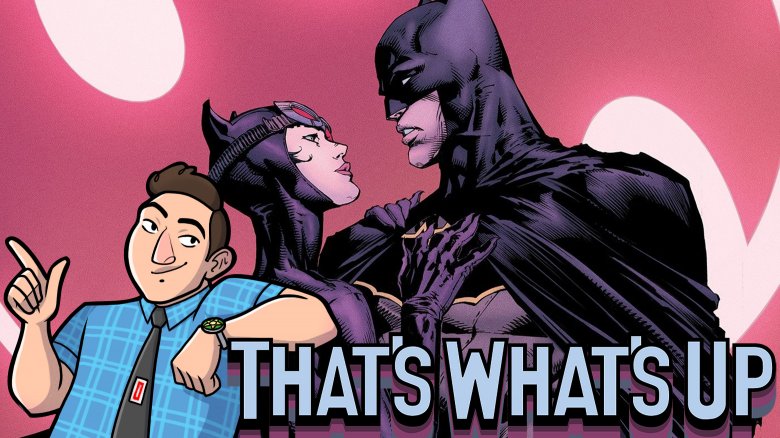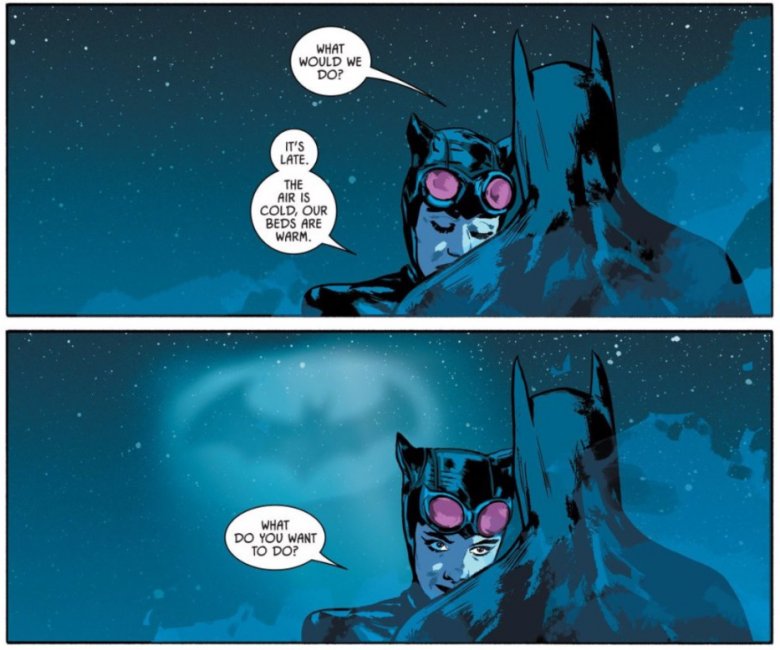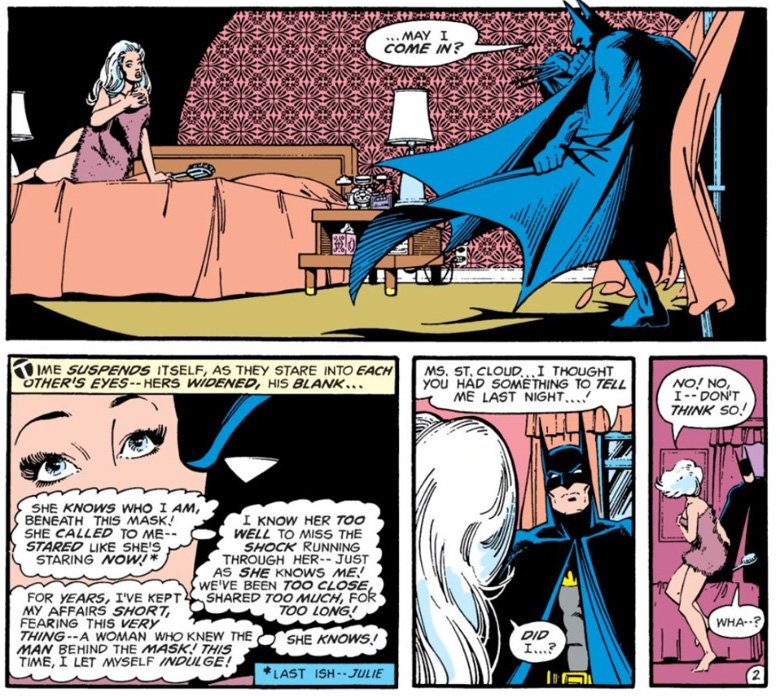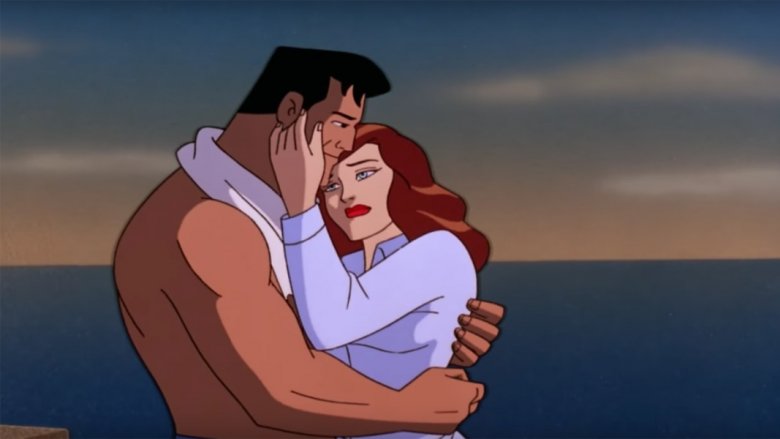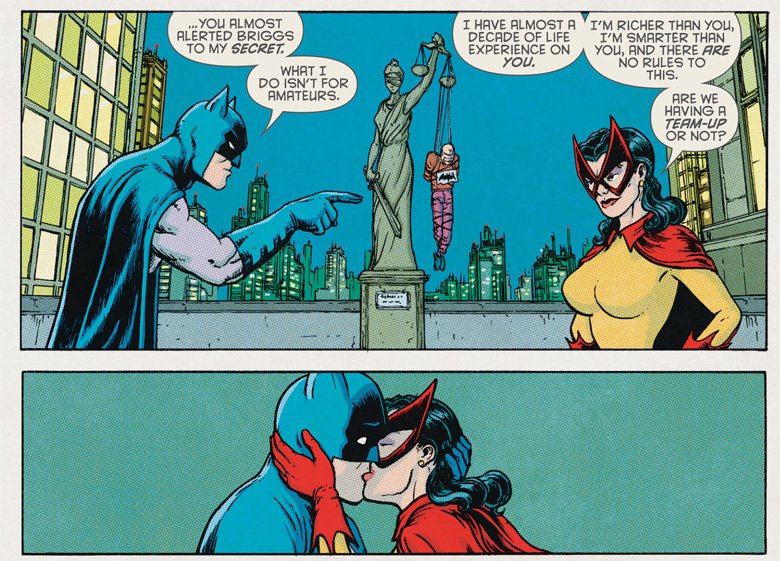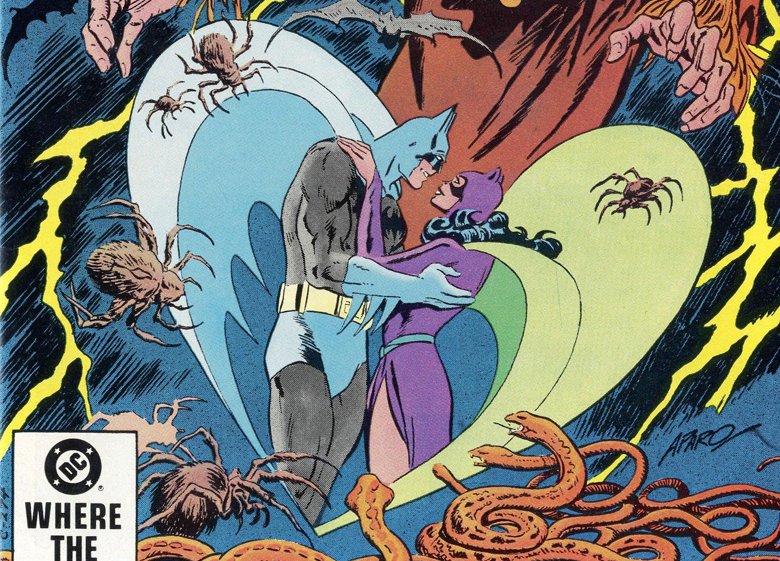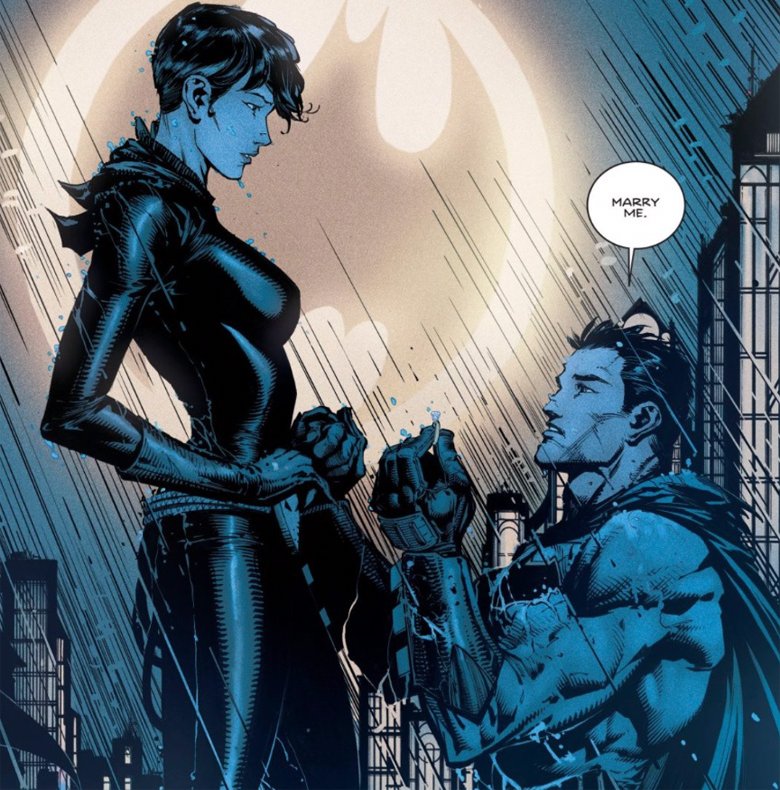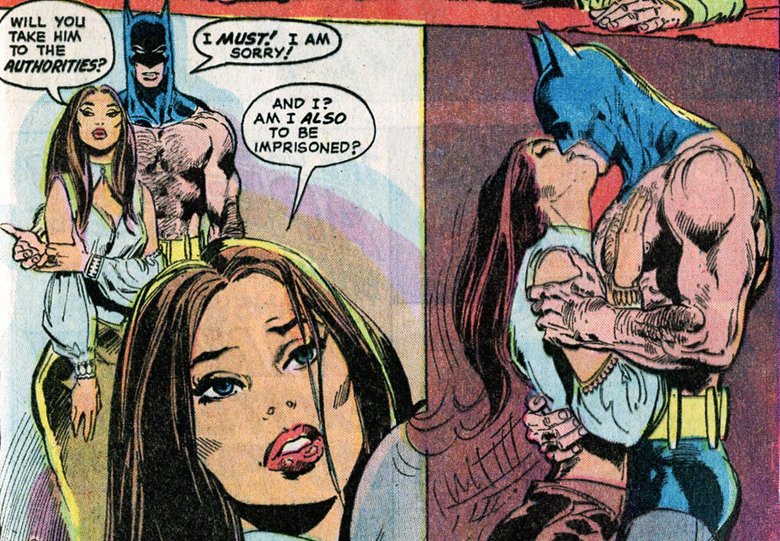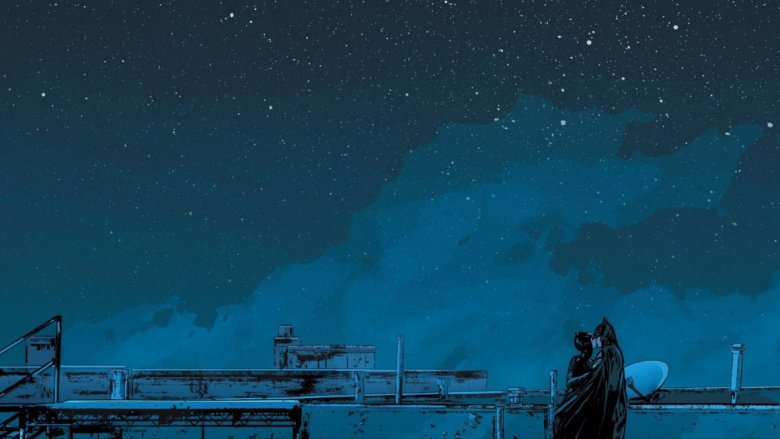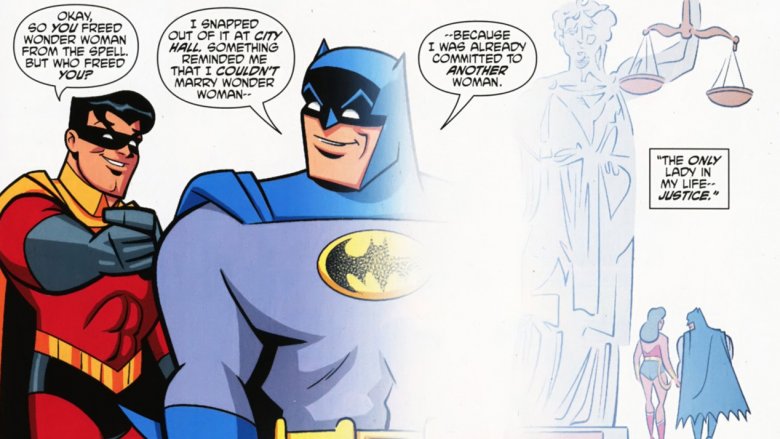That's What's Up: Is Batman Attracted To Criminals?
Each week, comic book writer Chris Sims answers the burning questions you have about the world of comics and pop culture: what's up with that? If you'd like to ask Chris a question, please send it to @theisb on Twitter with the hashtag #WhatsUpChris, or email it to staff@looper.com with the subject line "That's What's Up."
Q: What does it say about Batman that three of his most iconic loves, Catwoman, Talia and Andrea Beaumont, are criminals? Does Batman have a type? — Charlie Scott via email
I don't know where you're getting your information from, pal, but Batman hates criminals. I mean, it's kind of his whole deal, from the moment that his parents were gunned down and he made a solemn vow to spend his life waging war on crime! Why else would he dress up and go out every night looking for criminals so that he could tie them up, and run the risk of getting tied up himself, or attacked with a whip by a woman in a black latex cat costume who—oh. Oh.
Yeah, okay. I think I get where you're coming from now.
The many loves of Batman
Joking aside, you've got a solid point. That said, I think you're ignoring a few of the fundamental things that make Batman's love life so interesting, and it starts with your list of "iconic" loves.
Catwoman, of course, is definitely at the top of the list, and it's not even close. There's been a romantic tension between them for over 75 years, to the point where even the eternally square Batman of the Adam West show occasionally entertained the idea of running off with her and starting a sexy new life far away from his Gotham Cty crime-fighting duties. Her on-again, off-again love affair with Batman has become such a prominent part of her character that it permanently changed the way she works. Catwoman is so beloved—by both Batman and by the readers—that she can't really be a villain anymore in the traditional sense, and has been an ally and a protagonist in her own right since the '80s.
And if Catwoman's at the top of the list in a walk, then Talia al-Ghul makes for a strong second place. When Denny O'Neil and Neal Adams introduced her in 1971, they were pretty heavily inspired by On Her Majesty's Secret Service. As the James Bond fans among you may recall, that's a film that involves 007 heading to an impregnable mountain fortress and romancing—and eventually marrying—Teresa Draco, the daughter of a mastermind who heads up a notoriously powerful international criminal syndicate. Talia is pretty directly synthesized from those ideas, but taken to a superheroic extreme that would allow for Batman to go on the same type of Bond-esque world-traveling adventures that were so popular at the time. Plus, it's his affection for her and the bond they share through their son, Damian, that keeps him from going all-out to bring the League of Assassins down once and for all.
Andrea Beaumont, though ... Look, I'm as big a fan of Batman: Mask of the Phantasm as the next person—I'm willing to bet that I'm an even bigger fan than the next person, unless I'm literally standing next to the people who made it—but putting her as the third name on the list just doesn't feel right. If nothing else, it ignores the fact that there are far more prominent romances for Batman that definitely don't dress up in murder costumes and go looking for bloody revenge.
The many loves of Bruce Wayne
Silver St. Cloud, Vicki Vale, Shondra Kinsolving, and even Batman's first romantic foil, Julie Madison, are all characters who aren't even close to being crooks, and they're all at least as important as Andrea Beaumont. In fact, Silver in paticular has a much stronger claim on being an "iconic love." Not only was she the focus of the classic 1978 run by Steve Englehart and Marshall Rogers, which did a lot to lay down the groundwork for the modern age Dark Knight, her entire character arc is about coming to terms with the fact that she wanted no part of Batman's world of crime-fighting and villainy.
But there's a good reason why those characters can be so prominent within the Batman mythos without being involved in the superhero stuff: they're not Batman's love interests. They're Bruce Wayne's.
See, the classic superhero love triangle is built around the secret identity. It's one of the reasons that the most successful one is between Lois Lane, Clark Kent, and Superman—all of the tension of the classic relationship comes from the fact that Lois is in love with the Man of Steel and relatively uninterested in the mild-mannered reporter. With characters like Batman or Spider-Man, the tension plays on the idea that there's a part of their life that they can't share with others. Bruce Wayne's love interests can never really know who he is without knowing he's Batman, and since Batman's love interests tend to travel in slightly more crime-oriented circles, his secret's not exactly something he wants to chat about on a first date.
That's one of the reasons that Silver's so important as a character, because she shows how those two different parts of his life can collide in an interesting way. With a lot of classic superhero love interests, from Lois Lane to Steve Trevor, there's this idea that the heroes can't reveal their secret because it'll put the loved one in danger, or because they're just too dedicated to ridding the world of evil. For Silver, the fact that she finds out Batman's secret and then rejects him is a big moment, because it shows that to love Bruce Wayne is to understand that nothing's going to come before his mission, and she's not the kind of person who's willing to let her heart come in second. It gives her an agency that most other Batman love interests don't have, in that the heartbreak comes from her decision, not his.
Sex and the Single Phantasm
Andrea Beaumont, for all that she only really appears in that single story, is so memorable exactly because she plays with that same idea of smashing together those two halves of Bruce Wayne's life.
If you haven't seen Mask of the Phantasm, well, first of all, you should do that, because it's very good. Until then, here are the basics: Andrea Beaumont is a Gotham City socialite that Bruce Wayne falls in love with right at the start of his vigilante career, before he's inspired to strike fear into the hearts of superstitious, cowardly criminals by becoming the Batman. He's so taken with her that he's willing to abandon his plans to become a vigilante to be with her, going as far as begging his parents for forgiveness at their grave, and telling them that he never even considered the possibility of being happy again. It's an incredibly powerful scene, and one that's often overlooked when people talk about Kevin Conroy's greatest moments from his 25 years of being the voice of Batman.
Unfortunately for Bruce (and for the concept of crime as a whole), Andrea breaks it off with him and leaves Gotham City, and he channels his heartbreak into becoming Batman. Years later, when she reappears, he's dedicated his life to fighting evil, but—and here's your spoiler warning for the twist in a movie from 1993—she also has a masked identity that's consuming her life. She's the Phantasm, a terrifying vigilante armed with scythes who's out to murder the mobsters who killed her father.
It's a great plot—and one that was loosely adapted from Mike W. Barr, Alan Davis, and Todd McFarlane's Batman: Year Two—and it works because it ties together that dual-identity theme with the obsession that's a crucial part of how Batman operates. There's an idea that if they could just move beyond the tragedies of their past, these two characters could actually be happy together. Which, of course, can't happen. If it did, we wouldn't get any more Batman stories.
Dark Knight date night
That's why there are so many love interests that exist within that world of crimefighting: they're the ones whose existence doesn't conflict with the actual premise of the story. Batman stories are always going to be adventure stories first and foremost, and anything that detracts from that isn't going to be a good fit. But that doesn't necessarily mean that Batman's lovers have to be criminals.
The original Batwoman, for instance, was explicitly introduced to be a persistent love interest who was meant to stay around forever—or at least until Batman stories were able to shake the gay subtext of Batman, Robin, and Alfred all living together in a palatial mansion that Frederic Wertham obsessed over in Seduction of the Innocent
, where he called it a "wish dream of two homosexuals." Faced with the problem of giving Batman a love interest who could exist alongside his mission and who wasn't a villain, since the Comics Code prohibited any positive portrayals of criminals, Edmond Hamilton and Sheldon Moldoff basically just made, well, exactly what her name says she is: Batman, but a lady.
Kathy Kane was a wealthy socialite like Bruce Wayne who was also a former circus acrobat like Dick Grayson, who decided to fight crime for kicks. She had an array of gadgets—albeit extremely "girly" ones like anti-crime lipstick that she kept in a "Utility Purse" — and even brought her own Robin to the table in the form of the original Bat-Girl, her niece Bette Kane.
Perhaps unsurprisingly, Batwoman didn't stay all that prominent for long. She also never did manage to get rid of that subtext. Plenty of fans made it to the letters page by writing in support of the new character, but in 1964, she was quietly dropped from new stories, and in 1969, Barbara Gordon made her debut as the all-new Batgirl and proved to be far more popular and enduring than Kathy Kane ever was. But the fact that she existed at all, and that the stories got along just fine without her once she was gone, leads to an interesting conclusion about the way Batman's love life is presented.
It's not Batman who has a thing for criminals. It's the readers.
So… come here often?
Since the stories are structured to put the focus onto Batman's crimefighting adventures, it makes sense that pretty much everyone he's going to encounter in those stories is going to relate to that in some way. There's never going to be a story where Batman just hangs out with Carl From Work—his version of Carl From Work is Aquaman, and while they do sometimes hang out, it's mostly in the context of needing to beat up King Shark or solve a mermaid murder. A mer-der, if you will.
That same idea applies to everyone in his life, which is why his butler and surrogate father figure is also a former secret agent who also happens to be really good at sewing up bullet holes and figuring out how to get bloodstains out of bat-shaped kevlar capes. It's also why his most lasting romantic relationships are with people within that world, and in Batman's case, that's a road that almost always leads to villains.
I say "almost" because there are plenty of examples of it going the other way, too, from the aforementioned Batwoman to a relationship with Wonder Woman that was teased in the pages of JLA, to Sasha Bordeaux, who was hired as Bruce Wayne's bodyguard and wound up becoming Batman's sidekick so that she could protect him, and was then sent to prison where her death was faked so she could be recruited by a government agency and then become a secret agent cyborg. As you might've noticed, comics are weird.
With Batman, though, one of the biggest strengths of the character has always been that the villains in his rogues' gallery are some of the most compelling characters in comics. If there's going to be a truly lasting romantic foil for Batman, it's going to come from that side of his story. Which, of course, leads us right back to Catwoman.
Claws and affection
From day one, Catwoman has been Batman's most enduring love interest, and I mean that in a very literal sense. Her first appearance in 1940's Batman #1—which puts her arrival at only a month after Robin's and about 17 pages after the Joker's—literally ends with Batman musing that while she might be on the wrong side of the law, she was still a "lovely girl" with "lovely eyes." There's something there immediately that's worked its way through almost every permutation of the character, and provided the blueprint for later characters like Talia, or even Nocturna, the vampire thief who took him to court over custody of Robin. They all work for the same reason: it's instant drama.
There's always going to be something appealing about star-crossed lovers and people with something bigger than their own desires that's keeping them apart, and while there's a good chance that you already know this from, you know, school, that's not really unique to Batman comics. It's a time-tested trope that adds that extra layer of longing to any relationship, and with the Caped Crusader, that's way more compelling than anything that would involve juggling his secret identity, because it pits the very idea of romance against the thing that's at the core of his character. It asks the question of if it's possible for Batman to hate crime, but love a criminal.
Daughter of the Demon
The answer, of course, is no. That's why Talia was always the more sympathetic member of al-Ghul family. Ra's could be as hell-bent on killing off the majority of the world's population as he wanted, but Talia herself had to be a step removed from his plans. She could be part of them, sure, but never as the prime mover, which bred its own dramatic little set piece for her: the beautiful assassin, trapped between her devotion to her father and the love of his arch-nemesis.
That only really changed recently, and only then because there was something else to change the dynamic and add a different kind of drama: they had a son. This was something that had been alluded to in Mike W. Barr and Jerry Bingham's Son of the Demon graphic novel in 1987, when Batman and Talia were pronounced married by Ra's, and Talia got pregnant as the result of some wedding night bat-bedding. Later in the story, she claimed to have lost the baby, but at the end, it was revealed that Batman's son was still out there, having been given up for adoption. After that story came out, though, it was rarely mentioned again—although the alternate-future Kingdom Come story included a character called Ibn al-Xu'ffash, which translates from Arabic as "Son of the Bat," who was Bruce and Talia's kid.
When Grant Morrison and Tony Daniel reintroduced the idea in 2006 n the form of Damian Wayne, they took a bit of a different approach. Instead, he was the product of what Batman called a "eugenics experiment," artificially grown from their DNA and rapidly aged in a tank to become the perfect leader for the League of Assassins.
Either way, that changed the dynamic completely. Rather than being torn between Ra's and Batman, Talia was now inextricably tied to the Dark Knight as the mother of his son, and the tension came from the possibility that Damian could follow in her footsteps rather than his. That allowed Talia's character the freedom to change, pushing her further into evil than she'd ever gone before. It's worth noting that not all readers liked that change, because it shifted her away from her role as a love interest, but it shows how much had to be done to accomplish that.
Stolen hearts
With Catwoman, the role change took her into the opposite direction. By 2003, she'd been so firmly established as Batman's primary love interest that she learned his secret identity, but that didn't happen overnight. As early as 1977, it was established that the Catwoman and Batman of Earth-2, the multiversal home to DC's Golden Age characters, had been married, and there was a famous story in 1983 from Alan Brennert and Joe Staton that told the story of how they got together.
But there's one more twist to the idea that also comes through with Catwoman: whether or not Batman is attracted to criminals, the criminals are certainly attracted to him. Villains like the Riddler have an obsession with Batman that borders on a twisted sort of romance, and that's a border the Joker rolled past quite some time ago. Characters like Catwoman, Talia, and the Phantasm are just the characters for whom it's reciprocated.
At the end of the day, though, I still stand by my original answer. I mean, even if he is attracted to a few of the criminals he faces down, we all know that there's only room for one lady in his life.
Batman's true love
Lady Justice.
Each week, comic book writer Chris Sims answers the burning questions you have about the world of comics and pop culture: what's up with that? If you'd like to ask Chris a question, please send it to @theisb on Twitter with the hashtag #WhatsUpChris, or email it to staff@looper.com with the subject line "That's What's Up."
